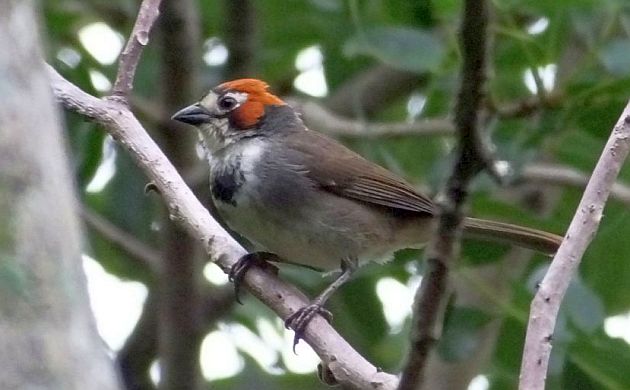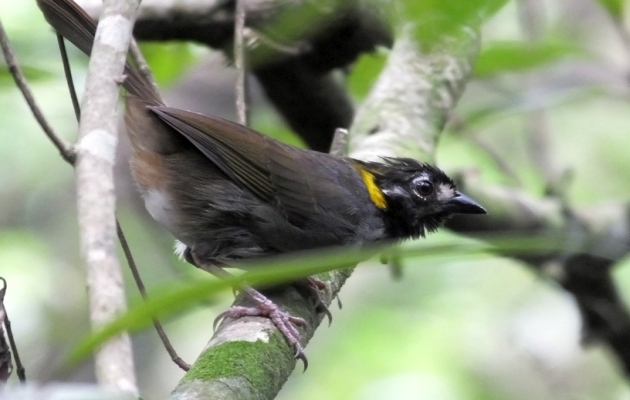
I won’t be answering any messages this morning, won’t be available. Won’t be taking any phone calls either but I’ve got a good excuse. Today, along with teams in a few other parts of Costa Rica and elsewhere, I will be birding for a cause, watching birds to help one that only lives in Costa Rica, the Cabanis’s Ground-Sparrow. Around the size of a Song Sparrow or Chaffinch, maybe a bit bigger, this mini towhee forages near the ground in dense scrubby vegetation. Although this endemic is high on the most wanted list of many visiting birders, unfortunately, it’s not an easy bird to see.
Trying to see a bird that skulks in dense vegetation is a challenge but when the bird is genuinly uncommon, the struggle is all too real. The Cabanis’s Ground-Sparrow is a bird in trouble. Listed as Near Threatened, this charismatic species has a tiny distribution restricted to central Costa Rica, especially in the Central Valley. It doesn’t require forest but the coffee farms and scrubby green space it does need are under constant pressure of being destroyed and replaced with urban housing. As I bird on this day, significant portions of its range are in immediate danger of being wiped out. Over a few years, I have already seen several places where I watched this species, even showed this species to visiting birders, bulldozed and prepared for housing. So many other sites for the bird get signed with “lots for sale”. The Cabanis’s Ground-Sparrow has the great misfortunate of living, needing, many of the same places where people want to build a house.
Habitat destruction is the main threat but unfortunately, it’s not the only challenge to survival. This endemic bird must also contend with outdoor cats, pesticides, cowbird parasitism, and maybe even competition from the slightly larger White-eared Ground-Sparrow.

Fortunately, local researchers have been well aware of the dire need to learn about this species so it can be adequately protected. In 2021, a huge step to protecting this species was made when vital life history data were published in a paper written by Roselvy Juárez, María de la Paz Angulo Irola, Ernesto M. Carman, and Luis Sandoval. The next steps involve learning more about their dispersal, home range, and other information needed to keep this special bird from racing towards extinction.
To make this happen, María de la Paz Angulo Irola and Ernesto M. Carman have organized a Birdathon to raise funds for the Cabanis’s Ground-Sparrow project. Past Birdathons organized by Paz and Ernesto have greatly helped research on migratory behavior of Cerulean and Golden-winged Warblers as well as field work with the Cabanis’s Ground-Sparrow. This year, they hope to raise funds to:
- Purchase more telemetry equipment and transmitters with a solar panel. This could help provide years of valuable data.
- Do more work on Ceruleans, actually following them on foot with a manual receiver to learn about their home range and habitat use at Las Brisas Reserve.
- Carry out workshops and train more people locally on how to do telemetry properly.
Check out the video!
The funds for this important project are raised through an organization called Rainforest Biodiversity Group (the legal name is Friends of the Great Green Macaw). They will be collected until June 16. To help protect this beautiful sparrow that only occurs in Costa Rica, please see the 2022 Birdathon GoFundMe page.
In the meantime, we will be out checking sites for Cabanis’s Ground-Sparrow. How many will be find? See the latest checklists at my eBird profile page. Hope you have a happy and birdy weekend!











This species certainly does look like its close relative in Mexico, the Rusty-crowned Ground-Sparrow! Fortunately, our version is listed as a species “of least concern”. Still hard to actually see, though.
Good luck with your project, and long may the Cabanis’s Ground-Sparrow skulk!
Thanks Paul!
There is possibly another problem, I visited a site in February where I had previously seen the species. The coffee was still there but the undergrowth was much reduced and we could not find the bird. I concluded that the habitat was no longer suitable.
If this is correct then it seems dependent on specific understory in coffee, presumably moving to a different area providing it can find some. Therefore suitable habitat may quickly become unsuitable.